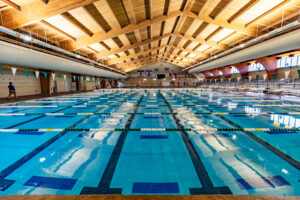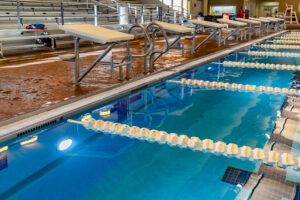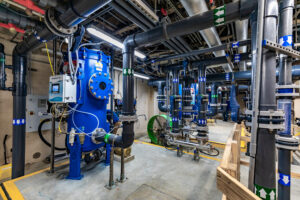Recreation Management: “Swimming Indoors”
Dave Ramont, Recreation Management [May 7, 2025]

Pearland Natatorium. Landmark Aquatic 2025
In the Houston suburb of Pearland, Texas, the Pearland Natatorium offers a wide range of activities. The competition pool hosts local, regional, and state-level meets, with the spectator seating ensuring that “family, friends and fans can come out to support the athletes,” said Brandon Jones, aquatics manager at the center. The pool also “serves as a practice venue for Pearland Independent School District swim teams, several youth recreation and competitive leagues, and competitive swim clubs. The venue is also used by water polo and diving organizations for training and events.
“Because of the depth offered in the dive well, the natatorium serves as a preferred site for special skills training by organizations like the U.S. Marine Corps, as well as local police and fire departments,” continued Jones. He pointed out that the pool is versatile enough to accommodate lessons for all ages and levels, fitness classes, lap swimming, and therapy programs. There are recreational swim times, events such as Movies in the Pool, facility rental opportunities, and unique programs like Introduction to Kayaking, Mermaid University, and more.
Pearland Natatorium reopened last December after renovations, and the activity pool now features “enhanced accessibility, and its design offers flow for various activities,” according to Jones. More specialized programming has been implemented since the updates, including one-on-one adaptive lessons for those with disabilities. A new transfer lift was added, “making the activity pool a space for the whole community to enjoy, whether for fitness or relaxation.”
Since appealing to a wide array of users is usually the goal, “The biggest challenge for a designer of an indoor aquatic facility is blending the needs and wants of the competitive, recreational, fitness, therapy, learn-to-swim bather, and all age groups in a finite and expensive area,” said Matt Cappello, director of design at Landmark Aquatic, the firm that worked on the Pearland Natatorium updates. “These programmatic discussions are extremely important on the front end of a project to develop buy-in from all groups for an inclusive experience that will maximize bather satisfaction while maintaining or increasing memberships.
“We see many natatoriums adding a multitude of features to bring in and keep bathers coming back,” continued Cappello. He explained that zero-entry pools, splash pads, and kiddie slides are well-suited for babies, toddlers, and their parents to “get them accustomed and confident to being in water.” And aquatic play units with tipping buckets, spray features, and slides provide entertainment for toddlers and grade schoolers, while climbing walls, zip lines, waterslides, inflatables, and current channels or lazy rivers provide fun for grade schoolers, teenagers, and adults. “Lazy rivers also provide exercise and therapy for water walking against the current.”
Cappello added that underwater bench seating is great for parents observing kids and for use in learn-to-swim programs. Also, “Safety and aesthetics can be enhanced at pool zero-entries, splash pads, and decks with the installation of safety padding.” He said safety flooring had been added to several of their projects to “add slip resistance, fall protection and provide artistic and/or branding opportunities.”
Another popular amenity Cappello described is the ninja-style obstacle course. “This feature can be retractable and provides a means for fun, fitness, and even competition within the facility or against competitors worldwide.” He mentioned the Sand Mountain Recreation Complex in Albertville, Ala., where his company designed a combination competition/leisure pool and a few years later a ninja-style system was installed. “Other amenities we see that are bringing people to indoor facilities are extreme features such as wave machines and surfing simulators.”
Offering multiple bodies of water indoors continues to be a trend, but Josh Martin, president and creative director at Martin Aquatic Design & Engineering, pointed out that this is a budget discussion. “We have a variety of projects that have a leisure pool and a training pool. Typically, this one body of water for the leisure pool has a mix of recreational programming, where the competition or training pool might include a movable bulkhead to allow for a variety of programming in both sides of the pool.”
And whether it’s a high school, college, YMCA, or municipal facility, offering features for competitions is common indoors. “Giving swim competitors the chance to practice their skills in an environment as close to the real thing is important for all venues,” said Martin, “which is why most of the lap pools we design will have starting blocks at a minimum.”
As for adding other elements such as timing systems and video displays, it comes down to the desires of the facility. “Most of these factors are also impacted based on the regional location and the ability to host larger events.”
If a facility is serious about hosting local, regional, or even national competitive events, then incorporating spectator seating, expanded deck spaces, and other support areas becomes a big consideration. “The architects we work with… usually plan the programming, but then we will also support the competitive environment with the design of a warmup pool,” said Martin. This allows athletes to prepare for competitions and also allows for future programming. “These pools serve as dual-purpose amenities that can be used for physical therapy, exercise and wellness, and learn-to-swim areas.”

Pearland Natatorium Bulkhead. Landmark Aquatic 2025.
Cappello said it’s very common to provide “stretch 25” pools (typically 25-yards by 25-meters) with a movable bulkhead, allowing for simultaneous swimming and diving, or even stretch 50-meter pools with bulkheads. “The ultimate competitive pool is a 50-meter by 25-yard pool with one or two bulkheads to allow for simultaneous 25-yard or meter swimming with springboard diving or water polo with cross-course 25-yard swimming.”
Movable floors are an excellent choice for enhancing competitive swimming, diving, and water polo programming and “deep water preferences while meeting the needs of the recreational or learn-to-swim (participants) in shallow water,” according to Cappello. But he pointed out that the features are rare due to cost. “What many don’t understand is that a movable floor provides the ability to meet the requirements of the recreational, learn-to-swim, and competitive needs without adding the cost of providing a second pool with a separate filtration system.”
In Arvada, Colo., the Arvada Aquatics Center (AAC) opened last November, replacing a swimming center built in the 1970s. The facility features a 50-meter competition pool with adjustable bulkheads. A diving well is equipped with three one-meter springboards, three three-meter springboards, and a three-meter and five-meter platform, making it a premier location for diving competitions. A secondary 25-yard pool features warmer water. “With the adjacent training pool, the opportunities for alternate programming are increased dramatically, ensuring it’s not only an athletic facility but a community facility,” said Robert McDonald, CEO and senior principal at OLC Architecture, which designed the center.
One of the largest natatoriums in Colorado, the center offers spectator seating for more than 800 and on-deck participant seating for 500 to 600. “The spectators enjoy unobstructed views of the action from the mezzanine that has its own temperature and humidity control system and daylit environment,” said McDonald, who managed the project. An advanced timing system built into the pool deck relays live results to a large scoreboard during competitions, heightening the experience for athletes and spectators.
Hillary Roemersberger is director of recreation services for the Apex Park & Recreation District, which manages day-to-day maintenance of the facility. She said the center is home to four high school teams for daily practices and hosts 15 of the 18 area high school swim and dive teams. “In addition, we also host practices and meets for local swim clubs as well as a club dive team. The facility is also utilized by local water polo teams and synchro groups. The bulkheads allow us to configure the pool in many different ways and give us the option to run a swim and dive meet simultaneously. The bulkheads also allow us to offer both short-course and long-course options.” Additionally, the center offers daily lap swim for the public, a Master’s swim team, learn-to-swim programs, aqua fitness programming, stroke clinics, and more.
Roemersberger said they prioritized larger and more accessible locker rooms during design to match the needs of their diverse customer base, as the old facility was “limited in both accessibility and inclusivity. The universal changing space offers a flexible option for our guests but also provides restrooms for coaches and officials separate from our athletes during meets.”
Added McDonald, “The locker rooms are designed to accommodate everyone in the community, be it an athlete, an exercise/lap swimmer, a family there for swimming lessons, or a participant with special needs.”
The AAC houses a multipurpose room that is used for a variety of purposes. “Typically, this space serves as a meeting room for internal and external use, lifeguard training programs, CPR/AED classes, and a coach’s space during meets,” said Roemersberger. Additionally, the center has “outside dedicated space for local coffee and food trucks that we partner with during larger meets.”
In line with Arvada’s commitment to sustainability, the AAC is on track to achieve LEED Silver certification. Some of the energy-efficient systems include water-saving filtration with regenerative media filters for efficient water re-use, reducing indoor water use by approximately 40%; energy-saving measures for HVAC systems, boilers, LED lighting, and more with an anticipated reduction of energy costs by 20%; and interior finishes, high-efficiency air filtration, and large ceiling fans helping to reduce indoor air pollutants and improve air quality.
Outdoor measures were taken as well, including the use of native landscaping and high-efficiency drip irrigation systems. And a grant-funded partnership with the Colorado Energy Office will fund the future installation of 10 EV charging stations, promoting greenhouse gas reductions.
McDonald said they’re seeing an “ever-increasing focus” on including sustainable design features, driven by an awareness of climate change, and “the reality that natural gas availability has a horizon that is not too far in the future. By increasing the energy efficiency of the mechanical and aquatic systems using all-electric equipment such as ground-source or air-source heat pumps, as well as installing onsite power generation through solar power, recreation and aquatic centers can be carbon-neutral and sustainable for the long haul.”
He said they’re also detailing high-performance building envelopes with insulation values in excess of code-required minimums and using daylighting strategies to help reduce power requirements.
The AAC is a partnership between the City of Arvada, Jeffco Public Schools, and Apex Park & Recreation District, and these types of arrangements and partnerships are becoming more common in many communities. “School districts across the country are struggling to fund critical infrastructure projects like adequate schools and transportation facilities, let alone athletic venues,” explained McDonald. “By turning to the local parks and recreation department or district and the municipality to help fund and operate the athletic programs via public recreation, it just opens up a whole new opportunity to provide access to swim lessons and exercise for school-aged kids.”

Pearland Natatorium Starting Blocks. Landmark Aquatic 2025
Cappello agreed that it’s increasingly common to see partnerships with communities and entities such as hospitals and YMCAs, providing a multitude of programming options. “One of the first organizations I saw providing indoor aquatics that include the gamut of programs with competition pools, leisure pools, therapy pools, and whirlpool spas was the Akron General Medical Center, now part of the Cleveland Clinic with several locations within Ohio.” He added that many health and fitness clubs, YMCAs, JCCs, and municipal facilities also provide multiple bodies of water to “meet the needs of the competitive, fitness, recreational, therapy, learn-to-swim, and lifeguard certification bathers.”
Looking at some non-water considerations in natatoriums, Cappello said that from an operational and maintenance perspective, the selection of deck equipment such as handrails, ADA pool lifts, lifeguard chairs, and starting blocks that can stand up to the humid and corrosive environment is critical. Additionally, “deck widths must comply with governing code minimums, but also support the non-bathers, lifeguards, and spectators. Window design is critical to bring in natural light while minimizing glare off the water for bathers, spectators, coaches, and especially lifeguards on the pool deck and in bleachers/seating.
“From a safety perspective, decks that are slip-resistant and prevent ponding of water are extremely important to not only comply with code requirements, but also prevent growth of bacteria, fungus, and other microbial growth,” continued Cappello. “Deck drainage should be well thought out to ensure pool water is efficiently removed.”
Depending on the type of atmosphere that a facility is trying to achieve, Martin said they’ve worked with a number of architects and owners who wanted their pool facilities to showcase specialty features. “To create a calming and luxurious environment for an older and more affluent membership base, a wellness center we designed included natural lighting for their indoor pool with floor to ceiling windows, as well as unique ceiling lighting to mimic the stars.” And while he said this is not a common request, it catered to a specific demographic.
Of course, the importance of air quality in a natatorium cannot be stressed enough. “No one likes the smell of chloramines, but beyond that, poor ventilation can be downright dangerous,” said Martin. He said that strong HVAC systems are critical for maintaining good air quality and also pointed out a “pretty simple solution” when applicable: bringing outside air inside with the use of a retractable roof. “There are great partners we work with who have provided this solution for our indoor waterpark and aquatic facility projects.”

Pearland Natatorium Regenerative Media Filter. Landmark Aquatic 2025
Cappello pointed out that poor air or water quality will not only create issues for visitors and staff, but also “degradation of the metallic items within the natatorium and all the equipment that the air and pool water come in contact with.” He said that maintaining good air quality is a function of a building’s HVAC/D mechanical design, “by sweeping the chloramine-laden air out of the building, maintaining acceptable temperature and humidity levels, and keeping a slightly negative air pressure within the space while washing any windows with warm air to prevent condensation from raining down.”
He added that source capture systems near the pool water surface have been around for years, and “have been successful in removing the chloramine-laden air through the gutter system, deck drain system, or benches.”
When it comes to water quality, “Filtration systems that are effective in removing particulate from the pool water are essential to keep pool water clear,” said Cappello, who added that they recommend regenerative media filtration if budgets allow. Additionally, “Supplemental sanitizers, such as UV, ozone, chemical enzyme additives, and hydroxyl-based advanced oxidation process systems provide a means to not only kill chlorine-resistant bacteria and viruses but also maintain appropriate levels of combined chlorine.”
And according to Cappello, another huge factor in maintaining a successful indoor aquatic facility is the operator, “who knows how to maintain the pool filtration, chemical treatment/monitoring systems, and building HVAC/D system. Staff who understand good pool water chemistry, building mechanical operation, and maintenance to equipment and pool items are hard to find, but essential in maximizing the life of a facility.”
– Dave Ramont, Recreation Management
May 7, 2025























